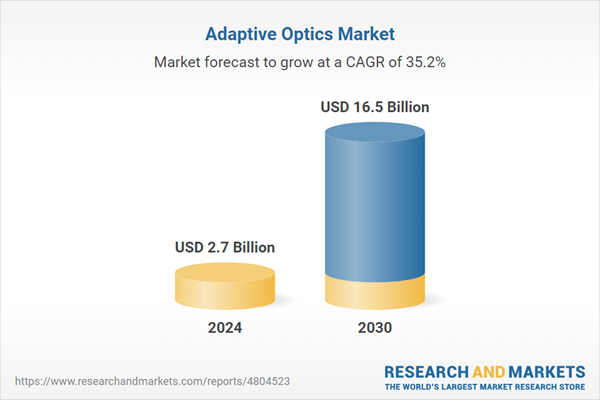Global Adaptive Optics Market - Key Trends & Drivers Summarized
Adaptive optics is a technology used to enhance the performance of optical systems by reducing the effect of incoming wavefront distortions. Primarily developed for astronomical telescopes to compensate for the blurring of images caused by the Earth's atmosphere, adaptive optics has found applications across various fields including ophthalmology, microscopy, and laser communication systems. The core principle of adaptive optics involves measuring the distortions in a wavefront and compensating for them with devices that can make precise alterations to the optical path, typically through deformable mirrors or liquid crystal arrays. This allows for sharper images and higher resolution in observing distant celestial bodies, examining microscopic structures in biological tissues, or improving the quality of optical communication signals.The application of adaptive optics has expanded dramatically with technological advancements. In astronomy, adaptive optics enables ground-based telescopes to reach resolutions that rival or exceed those of space telescopes, at a fraction of the cost. In the medical field, particularly in vision science, adaptive optics is used to produce highly detailed images of the retina, which can enhance the diagnosis and understanding of eye diseases. This technology is also crucial in the field of laser communications, where it helps in correcting distortions that occur through atmospheric turbulence, thereby allowing for more secure and reliable data transmission. The expansion of adaptive optics into these areas has been facilitated by improvements in components such as wavefront sensors and real-time control systems, which have become more sophisticated and capable of correcting distortions more quickly and effectively.
The growth in the adaptive optics market is driven by several factors, including technological advances in wavefront sensing and correction, increased investment in research and development by both public and private sectors, and a growing demand for high-resolution imaging in various applications. The technology’s utility in enhancing the resolution of astronomical observations continues to be a major driver, particularly with new, large-scale ground telescopes being developed. Similarly, in healthcare, the push towards more precise and personalized medicine is expanding the use of adaptive optics in diagnostic imaging and therapeutic applications, particularly in ophthalmology where detailed retinal scans can lead to better outcomes for patients. The increasing demand for high bandwidth communication systems also propels the adoption of adaptive optics in laser communications to correct signal distortions, providing a more stable and efficient data transfer. As industries continue to recognize the benefits of high-resolution and precise imaging capabilities, adaptive optics is set to play an increasingly important role in fields ranging from scientific research to consumer electronics and national defense.
Report Scope
The report analyzes the Adaptive Optics market, presented in terms of units. The analysis covers the key segments and geographic regions outlined below.Segments: Component (Wavefront Sensor, Wavefront Modulator, Control System); End-Use Industry (Military & Defense, Biomedical, Industrial & Manufacturing, Consumer, Other End-Use Industries).
Geographic Regions/Countries: World; United States; Canada; Japan; China; Europe (France; Germany; Italy; United Kingdom; and Rest of Europe); Asia-Pacific; Rest of World.
Key Insights:
- Market Growth: Understand the significant growth trajectory of the Wavefront Sensor segment, which is expected to reach US$9.2 Billion by 2030 with a CAGR of a 37.0%. The Wavefront Modulator segment is also set to grow at 34.1% CAGR over the analysis period.
- Regional Analysis: Gain insights into the U.S. market, valued at $1.0 Billion in 2024, and China, forecasted to grow at an impressive 39.0% CAGR to reach $2.9 Billion by 2030. Discover growth trends in other key regions, including Japan, Canada, Germany, and the Asia-Pacific.
Why You Should Buy This Report:
- Detailed Market Analysis: Access a thorough analysis of the Global Adaptive Optics Market, covering all major geographic regions and market segments.
- Competitive Insights: Get an overview of the competitive landscape, including the market presence of major players across different geographies.
- Future Trends and Drivers: Understand the key trends and drivers shaping the future of the Global Adaptive Optics Market.
- Actionable Insights: Benefit from actionable insights that can help you identify new revenue opportunities and make strategic business decisions.
Key Questions Answered:
- How is the Global Adaptive Optics Market expected to evolve by 2030?
- What are the main drivers and restraints affecting the market?
- Which market segments will grow the most over the forecast period?
- How will market shares for different regions and segments change by 2030?
- Who are the leading players in the market, and what are their prospects?
Report Features:
- Comprehensive Market Data: Independent analysis of annual sales and market forecasts in US$ Million from 2024 to 2030.
- In-Depth Regional Analysis: Detailed insights into key markets, including the U.S., China, Japan, Canada, Europe, Asia-Pacific, Latin America, Middle East, and Africa.
- Company Profiles: Coverage of players such as Northrop Grumman Corporation, Teledyne Technologies, Inc., Schott AG, Hamamatsu Photonics KK, Thorlabs, Inc. and more.
- Complimentary Updates: Receive free report updates for one year to keep you informed of the latest market developments.
Some of the 30 companies featured in this Adaptive Optics market report include:
- Northrop Grumman Corporation
- Teledyne Technologies, Inc.
- Schott AG
- Hamamatsu Photonics KK
- Thorlabs, Inc.
- Excelitas Technologies Corporation
- SCHOTT North America, Inc.
- Boston Micromachines Corporation
- Adaptica Srl
- Axiom Optics
- HOLOEYE Photonics AG
- Teledyne e2v
- Trioptics GmbH
Tariff Impact Analysis: Key Insights for 2025
Global tariff negotiations across 180+ countries are reshaping supply chains, costs, and competitiveness. This report reflects the latest developments as of April 2025 and incorporates forward-looking insights into the market outlook.The analysts continuously track trade developments worldwide, drawing insights from leading global economists and over 200 industry and policy institutions, including think tanks, trade organizations, and national economic advisory bodies. This intelligence is integrated into forecasting models to provide timely, data-driven analysis of emerging risks and opportunities.
What’s Included in This Edition:
- Tariff-adjusted market forecasts by region and segment
- Analysis of cost and supply chain implications by sourcing and trade exposure
- Strategic insights into geographic shifts
Buyers receive a free July 2025 update with:
- Finalized tariff impacts and new trade agreement effects
- Updated projections reflecting global sourcing and cost shifts
- Expanded country-specific coverage across the industry
Table of Contents
Companies Mentioned (Partial List)
A selection of companies mentioned in this report includes, but is not limited to:
- Northrop Grumman Corporation
- Teledyne Technologies, Inc.
- Schott AG
- Hamamatsu Photonics KK
- Thorlabs, Inc.
- Excelitas Technologies Corporation
- SCHOTT North America, Inc.
- Boston Micromachines Corporation
- Adaptica Srl
- Axiom Optics
- HOLOEYE Photonics AG
- Teledyne e2v
- Trioptics GmbH
Table Information
| Report Attribute | Details |
|---|---|
| No. of Pages | 196 |
| Published | April 2025 |
| Forecast Period | 2024 - 2030 |
| Estimated Market Value ( USD | $ 2.7 Billion |
| Forecasted Market Value ( USD | $ 16.5 Billion |
| Compound Annual Growth Rate | 35.2% |
| Regions Covered | Global |









